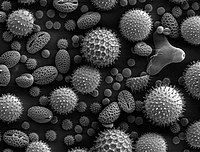
Photo from wikipedia
This paper presents the results of experimental studies of the interaction of helium plasma with a near-surface tungsten carbide layer. The experiments were implemented at the plasma-beam installation. The helium… Click to show full abstract
This paper presents the results of experimental studies of the interaction of helium plasma with a near-surface tungsten carbide layer. The experiments were implemented at the plasma-beam installation. The helium plasma loading conditions were close to those expected in the ITER divertor. The technology of the plasma irradiation was applied in a stationary type linear accelerator. The impact of the helium plasma was realized in the course of the experiment with the temperatures of ~905 °C and ~1750 °C, which were calculated by simulating heat loading on a tungsten monoblock of the ITER divertor under the plasma irradiation at the load of 10 MW/m2 and 20 MW/m2, respectively. The structure was investigated with scanning microscopy, transmitting electron microscopy and X-ray analysis. The data were obtained showing that the surface morphology changed due to the erosion. It was found that the carbidization extremely impacted the plasma–tungsten interaction, as the plasma–tungsten interaction with the carbide layer led to the carbon sputtering and partial diffusion towards to the depth of the sample. According to these results, WC-based tungsten carbide is less protected against fracture by helium than W and W2C. An increase in temperature leads to much more extensive surface damage accompanied by the formation of molten and recrystallized flanges.
Journal Title: Materials
Year Published: 2022
Link to full text (if available)
Share on Social Media: Sign Up to like & get
recommendations!